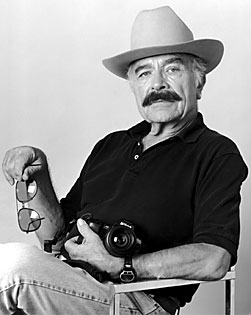 |
|
Photo courtesy of Beacon Press
|
Lee Marmon, father of local writer Leslie Marmon Silko, has been photographing Pueblo communities for more than 50 years. The
|
|
|
By Lindsey Muth
Arizona Daily Wildcat
Thursday October 16, 2003
Photographer, author capture decades of Pueblo history
Native American photographer Lee Marmon began photographing the elders of his Pueblo village more than 50 years ago. His photographs serve not only as a reminder of the changes that have taken place in the Pueblo culture over those years; they also beautifully preserve images of the people and traditions of that culture for future generations. Marmon has continued capturing on film the daily life images of the Pueblo people to this day.
This evening, at the Center for Creative Photography, Marmon and his daughter, author Leslie Marmon Silko, will talk about their new book, "The Pueblo Imagination: Landscape and Memory in the Photography of Lee Marmon."
The photographs from the book, "go all the way back to 1947," said Marmon. Many of the book's photographs are from the 1940s, '50s and '60s. "I just enjoy documenting the people," Marmon explained. Photos from the book will be enlarged and on display for the talk. Those who come to the discussion will have the opportunity not only to see images of a culture to which they may never have otherwise had access, but also to hear about the lives of the Pueblo people and the changes Marmon has seen and photographed over the years.
Marmon Silko wrote original pieces for the book, along with the book's introduction. "I always knew she would have to do the introduction, being a writer," said Marmon. "She accompanied me on several of the trips and was present when I was taking the photographs, so she was a natural to the book." The book also includes writings by poets Joy Harjo and Simon Ortiz.
Marmon was urged by those around him to compile his nearly six decades of photography into a book. "I didn't think of it until maybe a few years ago," Marmon said. "As I got older and more people saw my work, they began asking, 'why don't you put them (the photographs) into a book?'" Marmon's photographs stemmed from a predilection for documenting the people and landscapes of Pueblo life. "I just wanted to record the old folks for us to remember them," Marmon said.
Marmon's photographs are known for being faithful representations of their subjects. He chooses to use only natural lighting in his pictures. The photographs are taken without meticulous planning and setup (think the opposite of Anne Geddes' creepy moth-chrysalis babies or, more relevantly, the Kodak-color images of Native American culture you've seen in Hollywood movies). Marmon's photos are the real thing, the real people, in their real landscapes.
Those landscapes have changed over the last half-century. Marmon and Silko will address those changes during their discussion. Their talk will, "probably talk about the old days," said Marmon, "and the changes that have come to the reservation, and how different the young people have it nowadays with television and cell phones and cars and things like that."
|
Lowdown
Today 5:30 p.m.
Center for Creative Photography
Lee Marmon and Leslie Marmon Silko
|
|
For those who can't imagine functioning without their cellular-camera-phones and midnight vanilla latte runs to Circle K, the life of the Pueblo people only 50 years ago may seem unbelievably distant. However, Marmon's photographs serve to illustrate that there are links between Pueblo life today and Pueblo life 50 years ago.
Recognizing the differences between past and modern generations, and bridging those distances appear to be a natural outcome of Marmon's work.
For those who attend the talk, Marmon has a few gracious hopes. "I hope they get a little sense of history and a little more understanding of the Pueblo people, and I hope they like some of my photographs," said Marmon.
The talk will be an opportunity to take your education into your own hands for one afternoon, to hear about the changing Pueblo culture from two people who have been there to record the change. Not only that, but it will be an opportunity to view 50 years of photography documenting the Pueblo people.
If you are unable (but not unwilling) to attend this evening's event, Marmon will also be speaking at Reader's Oasis, 3400 E. Speedway Blvd., tomorrow night at 7. Both events are free and open to the public.
